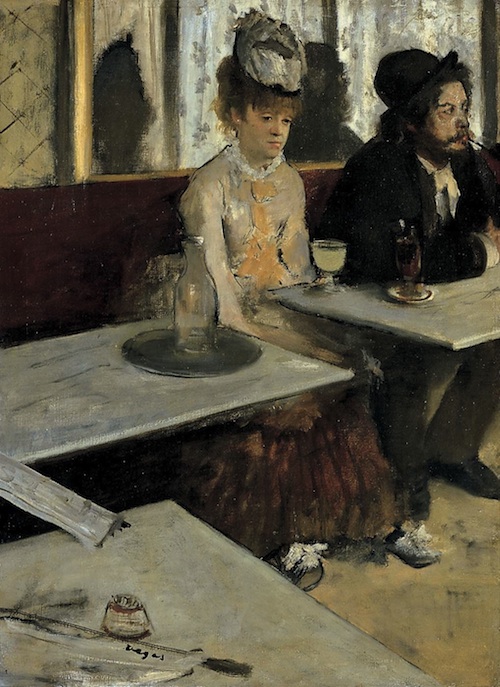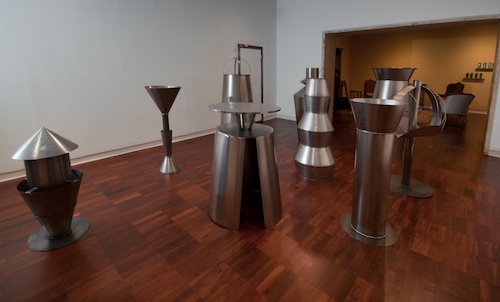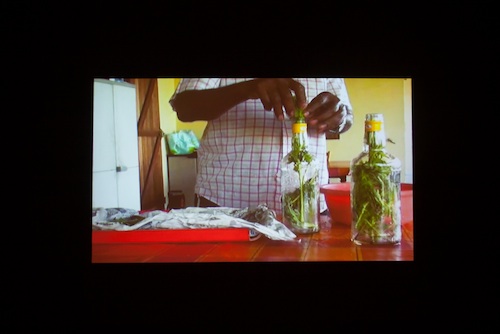
Edgar Degas. "L'Absinthe," 1876. Oil on canvas, 36.2 in × 26.8 in. Collection of Musée d'Orsay, Paris.
Absinthe is the famed drink of the modernist avant-garde. Degas, Gauguin, Van Gogh, Toulouse-Lautrec, Manet, Modigliani, and Picasso were all known to partake of the spirit. As the story goes, they weren’t just enjoying its mildly bitter and licorice-like flavor. Absinthe’s main ingredient, the wormwood plant species artemisia absinthium, was believed to contain mind-altering compounds. As Oscar Wilde told it, “After the first glass, you see things as you wish they were. After the second glass, you see things as they are not.” Not everyone extolled the high of “the green fairy.” Critics claimed absinthe was addictive, caused permanent lunacy, and contributed to social degradation. In vogue among the creative class of late 19th century France, by 1915 it was outlawed in most European countries and the United States.*
Tales of absinthe-era France will often cite Degas’ L’Absinthe (1876) to illustrate the drink’s supposed psychological effects and Manet’s A Bar at the Folies-Bergère (1882) as portrayal of Paris nightlife where the drink flourished. But mainstream art history will seldom (if ever) show us how absinthe spread from France to its colonies, namely the island of Martinique in the French Antilles. Though better known for its rums, absinthe has been produced in Martinique since the 1800s and continues to be part of the culture. Artist Marc Latamie brings this to light in a lovely solo exhibition now up at The Americas Society.

Marc Latamie. "For Rent" (detail), 2012. Sheet metal, variable dimensions. Courtesy of Americas Society. Photo: Wilson Santiago.
Born in Martinique, Latamie has in past exhibitions used coconut, sugarcane and other commodities to reference Caribbean colonial histories. Now taking absinthe as his focus, he’s erected the coolest of distilleries. Each of its sheet metal stills is modeled after one of the nine males or “malic molds” of Marcel Duchamp’s The Bride Stripped Bare by her Bachelors, Even (The Large Glass) (1915-1923). The forms give off the faint scent of anise and other aromatic herbs indicative of French aperitifs. A gallery attendant told me that this olfactory detail is merely for affect. These stills were never functional but meant to be symbolic — “an abstraction of what absinthe means.” The artist explains in the exhibition text, “I was trying to give this installation a dynamic based on the sense of desire, more than demonstration.”
Completing the distillery is Latamie’s version of Duchamp’s bride. It takes the form of a wooden shack, evocative of Caribbean architecture, penetrated by copper rods. The structure bears a single peephole that allows one to voyeuristically look inside, where a plant representing the tree of life sits on a jug of absinthe. Together, they mechanically rotate, suggesting, maybe, the drink’s evolution. But more than that, the gyrating movement conjures Duchamp’s chocolate grinder in The Large Glass, a thing repeatedly read as embodiment of the bachelors’ sexual frustrations.
Sentiments of desire and dissatisfaction flow through all three rooms of this exhibition. In the second one, decorated with 19th century French furniture, the artist invites people to lounge and drink, though absinthe tastings are by invitation only and limited to special events. Having visited on an uneventful weekday afternoon, I felt teased by the artist’s display of homemade absinthe. I had hoped for a tangible experience. Latamie has designed it so that absinthe is palpable, always near, but for the most part out of reach.

Myrtha Richards-Marie-Joseph. "L'Absinthe de Monsieur Gentil," 2012. Courtesy of Americas Society. Photo: Wilson Santiago.
Now, most claims about absinthe’s psychoactive and deleterious effects have been debunked over the last century. Yet marketers–and even I—still cling to ideas of the exotic, forbidden, and besotting. Absinthe is supposed to be the stuff of daredevils. Latamie responds to myth with a dose of reality. In a film projection titled L’Absinthe de Monsieur Gentil, the eponymous Mr. Gentil is shown at home in Martinique coolly preparing a batch of absinthe, and it’s not that extraordinary, really. It’s like watching a friend mix mojitos.
In the final room, the artist takes on the role of curator, hanging two-dimensional works by Gauguin, Matisse, Man Ray, and others who portrayed Martinican women and Caribbean landscapes. Called Le Salon (de) Surprise, the room is dedicated to Lumina Sophie, also known as Surprise, who “helped lead a revolt against wealthy white plantation owners” in the 19th century. She was imprisoned for blasphemy and, get this, “attempting to dominate men.” Relationships or the gaze between white men and brown women seems a sub-theme of this room. A suite of photos showing Man Ray and his lover from Guadeloupe, Adrienne Fidelin, are the most captivating portraits. What makes these images remarkable can be said for the entire installation: through the lens of absinthe we are shown histories that I, for one, might have never seen without Latamie’s insight.
*Recipes
This year is the 100th anniversary of the U.S. ban on absinthe, lifted only in 2007. Pernod Absinthe, the original maker of the spirit, has marked the occasion by releasing the joint gallery and bar crawl app Art & Absinthe Guide to Brooklyn. Created in partnership with Wagmag, the app offers a collection of recipes inspired by Pernod’s storied past in the art world. Here’s a couple created by local mixologist Alla Lapushchik:
Artist’s Truth Serum
0.75 part Pernod Absinthe Supérieure
0.5 part Lemon Juice
1 Sugar Cube
0.5 part Orange Juice
0.5 part Falernum
1 Lemon Wheel
Splash Sparkling Wine
Shake ingredients over ice, and strain into an ice-filled old fashioned glass. Top with sparkling wine. Garnish with lemon wheel.
The Gallerina
0.75 part Pernod Absinthe Supérieure
1 part Plymouth Gin
1 part Rye Whiskey
0.5 part Royal Combier
5 Dashes St. Elizabeth Allspice Dram
2 Dashes Bittermens Burlesque
Bitters
1 Orange Twist
Stir ingredients over ice, and strain into a chilled martini or couple glass. Garnish with an orange twist.
For Rent: Marc Latamie continues through July 28. An absinthe tasting has been rescheduled for Friday, June 22 @ 7pm. Registration is required. Email [email protected].





Pingback: Absinthe and the Art World | Nicole J Caruth
Pingback: Wednesday links | Tyler Green: Modern Art Notes | ARTINFO.com